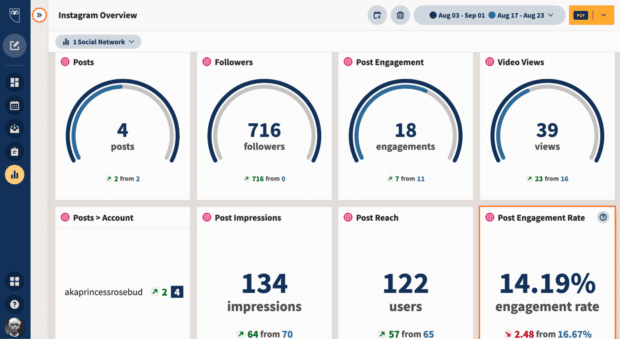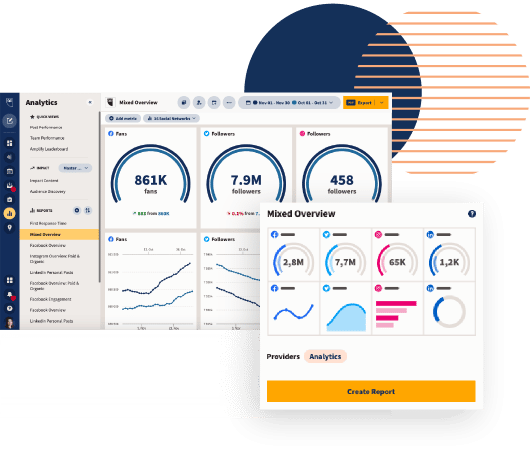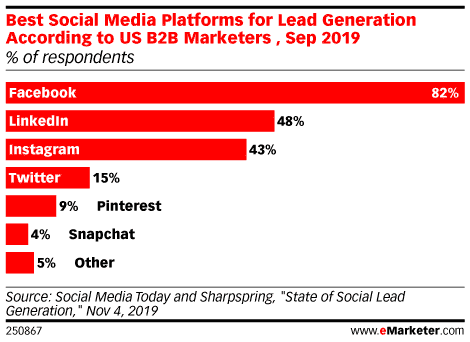You may be great at making compelling content for social media. But turning business jargon into clear social media marketing goals can be intimidating. Sure, your latest TikTok may be racking up the views, but how does that contribute to your company’s bottom line?
By now, most businesses know that social media marketing can be valuable for their brand. It’s just that often, companies aren’t totally sure what that value is. That’s where social media goals come in.
With this guide, you’ll be able to set clear goals for social media marketing. We’ll help you figure out what your company needs and how social can help you get there.
Bonus: Get a free social media analytics report template that shows you the most important metrics to track for each network.
What are social media goals?
A social media goal is a statement about what you want to achieve with a specific social marketing tactic or your whole social strategy. Good social media goals align with broader business objectives. Examples of common social media goals include generating leads, driving traffic to a website or online store, or getting more followers.
Social media goals can apply to anything from a single ad or organic post to a full-scale campaign.
Social media goals aren’t the same thing as your social media strategy. Instead, think of goals as components of the larger strategy.
Why do social media marketing goals matter?
Clear social media goals give you a target to aim for and can help you get buy-in from your manager or other stakeholders.
Well-made social media marketing goals will also help you:
- manage your budget,
- structure and streamline your workflow,
- prove your marketing’s return on investment,
- and align your social media activity with your organization’s broader business objectives.
9 examples of social media marketing goals
The social media goals you set should always reflect your specific business needs. But many goals can apply to almost any social media campaign. Some campaigns can even contribute to several goals at once.
Here are some examples of common social media goals and the metrics you can use to measure their success. These can help you frame your work in concrete, actionable terms.
1. Increase brand awareness
Building brand awareness means increasing the number of people who know your brand. This goal is best when launching a new product or breaking into a new market.
Of course, expanding your audience never hurts. But brand awareness is usually the first step on the road to bigger things.
You can measure brand awareness on social media with specific metrics like
- Post reach<span data-preserver-spaces="true">:</span> How many people have seen a post since it went live.
- Audience growth rate: The rate at which you gain followers over time.
- Potential reach: The number of people who might see a post during a reporting period.
- Social share of voice: How many people mention your brand on social media compared to your competitors.
Need help tracking brand awareness? Specialized social media management tools like Hootsuite can help.
Hootsuite Analytics makes measuring brand awareness metrics easier by allowing you to track metrics from multiple social networks, all in one place. You can even export the information or create custom reports to share with colleagues and stakeholders. The tool collects data from Instagram, Facebook, TikTok, LinkedIn, and Twitter.
Watch this 2-minute video to learn more about how to use Hootsuite Analytics.
Try it for free. You can cancel anytime.
Video social media platforms are great for building brand awareness. If this is one of your goals, try social media channels like YouTube, TikTok, Instagram Stories and Reels. After all, watching videos is the fourth most popular reason people use the internet.
2. Manage brand reputation
Social media marketing is one of the top tools you can use to build trust in your brand. These days, trust drives growth. This social media objective measures public attitudes about your brand.
The metrics for measuring reputation are like those for brand awareness. Of course, you’ll track brand mentions and relevant hashtags. But you’ll also want to watch what people say about you even when they don’t tag you.
Tools that measure social media sentiment, like Hootsuite Insights, can help you keep up with the conversation.
In addition to traditional social media, think about using social audio platforms. Clubhouse, Twitter Spaces and Spotify can be great for this.
For example, 22.9% of internet users between 16 and 64 listen to online radio shows or stations each week. That number’s even higher (39.6%) if we’re talking music streaming services. Capturing user attention on these platforms allows you to build your brand’s reputation.
3. Increase traffic to your website
Social media marketing goals aren’t limited to actions that happen on social. Your website is a key player in your social media strategy. This matters whether you’re trying to drum up sales or move people down your social media marketing funnel.
Measuring website traffic in analytics is relatively simple. Here are some of the top metrics you should keep an eye on:
Measuring website traffic in analytics is relatively simple. However, here are some of the top metrics you should keep an eye on:
- Traffic to your site. It’s obvious, but don’t forget to limit your reporting to the most relevant period. This can be daily, weekly or monthly. If you have a baseline number to compare traffic to, even better!
- Network referrals. Monitoring referrals can help you determine which platform is working best.
- Email sign-ups. Once your social traffic makes it to your website, are they signing up for more of your content?
Pro tip: For more on tracking social media ROI using Google Analytics, check out our guide!
Bonus: Get a free social media analytics report template that shows you the most important metrics to track for each network.
4. Improve community engagement
Engagement is any type of visible interaction with your brand on social media. For example, likes, comments and shares on your posts are all forms of engagement.
Engagement is sometimes considered a vanity metric, but that’s not always true. These softer signals can help you track how well your content meets your target audience’s needs. Improving engagement means better quantity or quality interactions with your audience.
There are several ways to calculate social media engagement rates. Here are a few examples:
- Engagement rate by reach (ERR). The percentage of people who chose to interact with your content after seeing it. You can calculate this by individual post or average it over time.
- Engagement rate by posts (ER post). Similar to ERR, but measures the rate that your followers engage with your content.
- Daily engagement rate (Daily ER). How often your followers engage with your account on a daily basis.
If calculations make your head spin, we’ve got you. Hootsuite’s free engagement calculator can do the work for you!
You can also use a social media analytics tool like Hootsuite to always have the most up-to-date engagement insights handy and easily build engagement reports to prove the effectiveness of your social strategy.

Try it for free. You can cancel anytime.
5. Boost conversions or sales
A conversion is when a user takes action on your social media posts or website. This can mean signing up for a newsletter, registering for a webinar, or making a purchase.
If your social media presence isn’t translating into sales, try focusing on conversion.
Depending on your specific business goals, you can measure conversion in several ways:
- Conversion rate: The number of visitors who, after clicking on a link in your post, take action on a page divided by that page’s total visitors.
- Click-Through Rate (CTR): How often people click on the call-to-action link in your post.
- Social media conversion rate: The percentage of total conversions from social media.
- Bounce rate: The percentage of users that click on one of your links only to leave without taking any action. (Sadly, this is not how often you listen to Big Freedia.)
Social platforms or campaigns with integrated shopping tools are great for conversion goals. These include Pinterest Product Pins, Facebook Shops, Instagram Shops, TikTok, and Shopify.
6. Generate leads
Not every social media interaction will result in a sale — and that’s ok. If you want to fill your funnel with potential customers, you might want to set a goal to generate more social leads.
Lead-generating campaigns yield any information that helps you follow up with a social media user. That includes names, email addresses, occupations, employers, or other information they share.
Leads are a specific kind of conversion. Because of this, the two goals are useful in similar situations. They’re also measured in similar ways.
Generally speaking, Facebook is the best platform for generating leads. This edge comes from its massive audience size and sophisticated analytics tools.
To learn more about generating high-quality leads, we’ve put together a guide dedicated to social media leads.
7. Deliver customer service
Your social presence isn’t just about attracting new customers. It’s also a place to keep the customers you already have. Goals to improve customer service on social media can take on a variety of forms, including:
- Establish a new customer support channel on social media
- Reduce wait times
- Increase customer satisfaction
Measuring the success of your social customer service will depend on your goal. Usually, you’ll use data from customer testimonials and customer satisfaction surveys.
Internal measurements like the number of service requests handled per customer service representative can also be useful.
Conversational social media platforms like Twitter and Facebook are a good place to focus on your customer service goals.
If you don’t quite have the time or team capacity to answer every single question on social media, automate! A social media AI chatbot like Heyday will help you streamline your work and never leave a customer inquiry unattended, no matter the size of your team.
8. Gain market insights with social listening
If your top priority is finding out what you need to know, you might want to set a goal to improve your business’s social listening.
Social listening is a two-step process. First, track social media activity relevant to your brand. Then, analyze that information for insights about your company or industry.
The main metrics to track in social listening include
- Brand mentions. How many people are talking about your brand?
- Relevant hashtags. Are people participating in conversations relevant to your brand or industry?
- Competitor mentions. How often are people talking about your competitors (and what are they saying)?
- Industry trends. Is interest rising in your key products? Do you need to pivot to meet new demands?
- Social sentiment. What’s the general tone of the conversation on social?
Clear social listening goals can help you engage with your audience more effectively. They also help show the value of social marketing next time budgeting season rolls around.
9. Attract candidates for open positions
Using social media to fill open positions in your company is another kind of conversion. In this case, you’re targeting a particular type of user interaction: submitting a resume.
When recruiting for an open position, quality conversions are way more important than quantity. LinkedIn is usually (but not always!) your best bet for finding an engaged audience.
When tracking social recruitment, keep an eye on metrics like these:
- Number of leads per platform. Is Instagram sending more candidates than LinkedIn?
- Source of hire. Once a hiring decision has been made, review where the candidate came from. Maybe that flood of Instagram-generated leads was mostly spam.
Set SMARTer social media goals in 5 steps
Set social media goals that get you where you need to be by making them SMART. They should be specific, measurable, <span data-preserver-spaces="true">a</span>ttainable, relevant and time-bound.
Specific
What exactly do you want to achieve? It’s fine to start with a general direction, but try to get as precise as possible.
For example, you don’t just want to increase the size of your audience. You want to increase the number of followers you have on LinkedIn. There, that’s specific!
Measurable
How will you know when you’ve achieved your goal? A measurable goal uses specific social metrics to define success.
Now we need to add some numbers to our example goal above. Let’s say that you want to double the number of LinkedIn followers. Boom, the goal is now measurable!
Attainable
It can be tempting to aim high but don’t set yourself up for failure. If you just launched but want to reach a million dollars in sales by next week, you might be dreaming a little too big.
Let’s check in our example goal. Is doubling your LinkedIn followers an attainable goal? In this case, you’ll want to look at your account’s growth over the past few months. Make sure that your historical performance supports your goal.
Relevant
Does the goal fit into a bigger plan? Remember, goals are just a piece of your overall social media marketing strategy. Each goal should help support your business objectives.
How’s our example goal looking? If you’re a B2B social media marketer, pretty good! In this case, focusing on a business-focused platform like LinkedIn makes sense.
Time-bound
If your goal doesn’t have a due date, it’s easier to put off. We want to make sure we accomplish these social media goals, so be sure to set a timeline for completion.
We started by wanting to increase the size of your audience. Now, we know that you want to double your LinkedIn followers within six months. Our example goal now fits the SMART criteria!
What are your social media goals?
No matter your broader social media marketing objectives, SMART social media goals can help you succeed. At worst, you’ll learn from your mistakes!
If you want to become an expert in goal setting for social media marketing, we can help. Hootsuite’s Social Marketing Certification course has a section about setting strategic goals.
Use Hootsuite to achieve your social media goals across all platforms. Easily schedule and publish posts, interact with your audience, monitor conversations around your brand, and measure performance with real-time analytics — all from one dashboard.
Do it better with Hootsuite, the all-in-one social media toolkit. Stay on top of things, grow, and beat the competition.
The post How To Set and Exceed Social Media Goals [9 Examples] appeared first on Social Media Marketing & Management Dashboard.
![How To Set and Exceed Social Media Goals [9 Examples]](https://localseoresources.com/wp-content/uploads/2022/05/Artboard-1-copy@2x-1.png)






Recent Comments